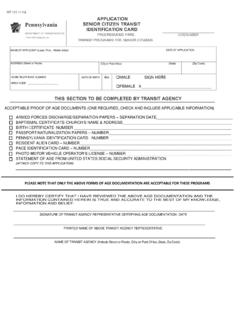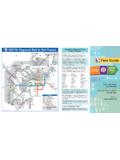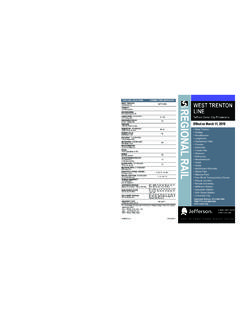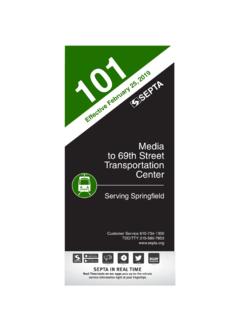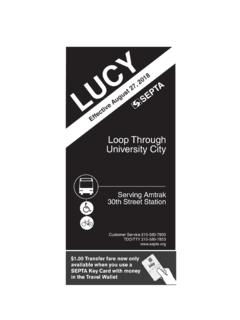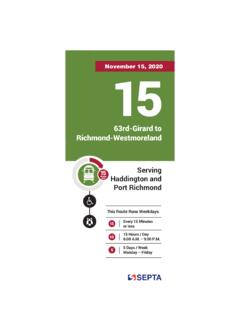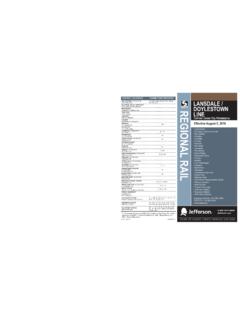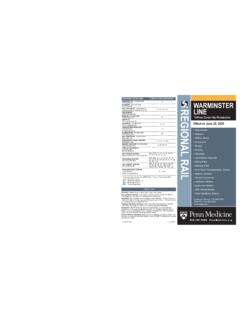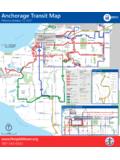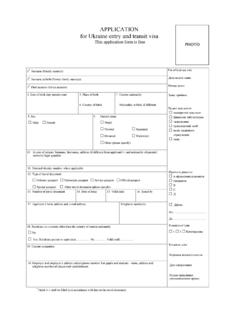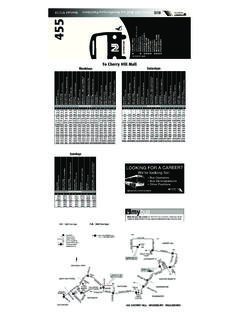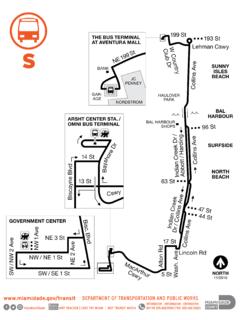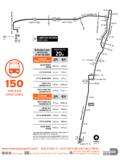Transcription of APPLICATION REDUCED TRANSIT FARE …
1 PART I - TO BE COMPLETED BY APPLICANT (Please print or type)PART II - TO BE COMPLETED BY PHYSICIAN OR AUTHORIZED AGENCY (Please print or type)MT-301 (5-18) APPLICATION REDUCED TRANSIT FARE IDENTIFICATIONCARD REDUCED TRANSIT FARE PROGRAM FOR PERSONS WITH certify that the above named individual qualifies for a disability REDUCED Fare TRANSIT Identification Card because: (please check as manyreasons as are applicable. For further explanation please see reverse side)._____ (1) The person possesses a Medicare Card and is under 65 years of (2) The person cannot negotiate a flight of stairs or escalator with ease, reasonable speed, and/or without aid from another (3) The person cannot board or leave a TRANSIT vehicle with ease, reasonable speed, and/or without aid from another (4) The person cannot stand without major support in a moving vehicle operating under normal acceleration and (5) Due to uncorrectable visual impairment the person cannot read TRANSIT vehicle identifications or identify TRANSIT (6)
2 Due to uncorrectable hearing impairment, the person cannot hear verbal announcements or TRANSIT information through either direct personal or electronic (7) The individual needs (for valid medical reasons) the aid of a cane, crutches, or other mechanical device to assist him or her in moving (8) Due to physical or mental conditions, the person cannot use public TRANSIT without the help of another person or special person's disability can generally be described as:In cooperation with the Federal TRANSIT AdministrationCard Number _____Name of Applicant (Last, First, Middle Initial): Date:Address (Street, City, State, Zip Code):Telephone No.
3 Birth Date: Signature:rMalerFemale_____ 1. The disability is permanent ( will last longer than twelve months)_____ 2. The disability is temporary and can be expected to last until _____/_____ Month YearDue to the disability indicated above I hereby certify that the above named applicant is unable to utilize mass TRANSIT facilities and servicesas effectively as persons who are not so affected, and to the best of my knowledge the above information is true and (Street, City, State, Zip Code).
4 Telephone SIGNATURE Date_____Name of Agency or Physician Pennsylvania License #When properly completed please return to participating TRANSIT OF FUNCTIONAL IMPAIRMENTS FORREDUCED TRANSIT FARE PROGRAM FOR PERSONS WITH DISABILITIESThis Program is required by Section 5 of the Urban Mass Transportation Act of 1964, as Amended1. The person possesses a Medicare Card and is under 65 years of age.
5 Any person who qualifies for Medicare need not have this form certified by a physician or social service agency, but may obtain a card from the TRANSIT agency directly upon presentation of his or her Medicare Card. A person over 65 years of age qualifies under Pennsylvania's Free TRANSIT Program for Senior The person cannot negotiate a flight of stairs or escalator with ease, reasonable speed and/ or without aid from another The person cannot board or leave a TRANSIT vehicle with ease, reasonable speed, and/or without aid from another person. Standards 2 and 3 have to do with the person's walking and step climbing ability as it relates to the use of rapid TRANSIT systems, buses or trolleys.
6 In order to meet either of these standards the person should have significant difficulty in: a. Climbing steps with risers 7 inches or more in height. b. Negotiating a long flight of stairs. c. Climbing from ground to first step on the TRANSIT vehicle, a distance of approximately 14 inches. Examples of typical ailments which may qualify under these standards: a. Amputation of or anatomical deformity of foot or leg. b. Major restrictions in the movement of joints in hips, back, knee or ankle. c. Fracture of femur, tibia, tarsal bone or pelvis. d. Disorders of the nervous system resulting in moderate motor weakness in two The person cannot stand without major support in a moving vehicle operating under normal vehicle acceleration and deceleration conditions.
7 This standard is based on the person's inability to stand in a moving bus, trolley, train or subway car even with the aid (by holding with the hand) of a stanchion or overhead rail. Examples of typical ailments which may qualify under this standard: a. Loss of balance due to inner-ear disorders. b. Disorders of the nervous system resulting in moderate motor weakness in two extremities. c. Disorders of the nervous system resulting in moderate lack of coordination of motor functions. d. Amputation of or major anatomical deformity of foot, leg, arm or hand. e. Fracture of femur, tibia, tarsal bone or Due to uncorrectable visual impairment the person cannot easily read TRANSIT vehicle identifications or identify TRANSIT stops.
8 This standard automatically applies if the visual efficiency of the better eye after best correction is 20% or less. (The percent of remaining visual efficiency equals the product of the percent of remaining central visual efficiency and the percent of remaining visual field efficiency .)6. Due to an uncorrectable hearing impairment; the person cannot hear verbal announcements or TRANSIT information through either direct personal or electronic communication. This standard applies if manifested by: a. Absence of air and bone conduction in both ears (auditory perception of not more than one pure tone at high volume will be considered as absence of air and bone construction); or b.
9 No more than 40 percent discrimination for speech (ability to hear and understand no more than 40 out of 100 words of special test lists of words using a speech audiometer or hearing aid).7. The individual needs (for valid medical reasons) the aid of a cane, crutches, or other mechanical device to assist him or her in moving about. This standard would include individuals utilizing wheelchairs, long leg braces or other orthopedic appliances which are needed for medically valid Due to physical or mental conditions the person cannot use public TRANSIT without the help of another person or special training. The person's need for the aid of another person or training under this standard may be for physical aid and support or guidance.
10 Organic brain syndrome, functional disorders, or mental deficiencies resulting in severe mental and social incapacity as evidenced by marked dependence upon others for personal needs or to avoid physical danger or the inability to understand the spoken word or the inability to follow simple directions would meet this standard. An IQ of 49 or less automatically qualifies the individual. Special training includes formal or informal training to help the individual find TRANSIT stops or stations, to help in boarding the vehicle, to relieve unreasonable fears or anxieties or to reduce the probability of violence .NOTE:If a person with a disability requires assistance from another person, that individual must pay the regular fare.

